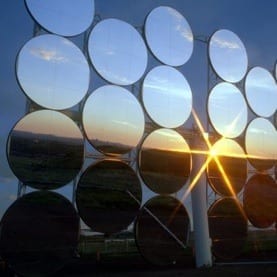New approaches, not yet ready for a rooftop near you, explore simple designs that are different from what’s out there
Most photovoltaic solar cells have an inherent efficiency cap, limiting how much useful energy they can extract from the sun. But scientists are finding ways around this obstacle with new research that could make solar energy more efficient and more cost-effective.
At the National Renewable Energy Laboratory (NREL) in Golden, Colo., researchers are investigating how to get a unit of light to push more than one electron at a time. Meanwhile, a team at the Massachusetts Institute of Technology is working on getting the right type of light to hit solar cells to make sure its energy doesn’t go to waste.
“One of the major limitations of solar energy conversion is that these high-energy photons are not efficiently converted. You lose a lot of energy to heat,” said Matthew Beard, a senior scientist at NREL. He co-authored a paper last week in Science that demonstrated a device that, at the quantum level, peaked at 114 percent efficiency using a process called multiple exciton generation (MEG).
“It operates in some ways the same way a traditional solar cell would,” said Beard. “Instead of bulk crystals, it uses quantum dots.” Most solar cells are made of a sandwich of two crystal layers: one that’s slightly negatively charged and one that’s slightly positive. The negative crystal has extra electrons, and when a photon with enough energy strikes the material, it dislodges an electron on the positive side, increasing its energy and leaving behind a “hole.” The electron-hole pairing is called an exciton.
MEG is one of the technologies at the vanguard of “third-generation” solar technology. Using these advances, solar panels can be thinner, lighter, cheaper, more flexible and fundamentally more efficient than current devices on the market. As a result, solar energy will be more cost-effective and will form a greater share of the world’s energy portfolio.
But first these panels must bypass the Shockley-Quiessler limit, the bane of current-generation photovoltaic systems.
Saving wasted solar energy
The “SQ” limit describes the maximum efficiency of a solar cell using a conventional single-layer design with a single semiconductor junction. For most common solar cell materials, the efficiency limit is about 32 percent in ideal conditions. This means that at least two-thirds of the energy from sunlight that hits a solar panel is wasted, more if you account for losses from reflections, wiring and mounting hardware. The efficiency increases if you add layers to the cell, but this substantially raises the device’s price and complexity. Currently, multi-junction solar cells are limited largely to satellites, where the need for efficiency, low weight and small space trumps cost concerns.
Now scientists are tweaking solar cell materials at nanometer scales to squeeze out better performance without increasing their prices or complexity, finding loopholes through the SQ limit.









